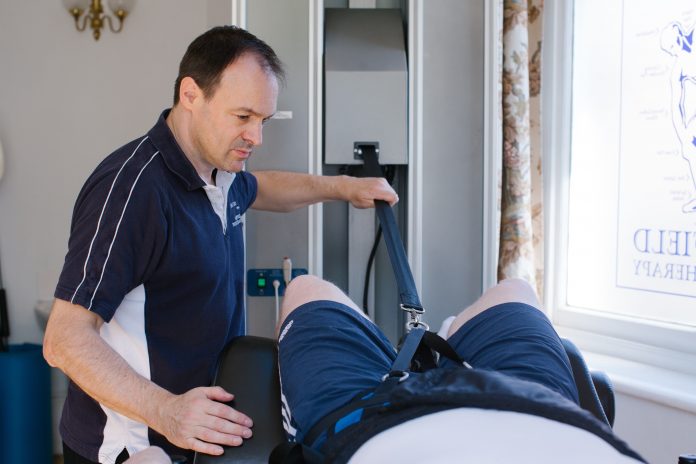John Wood MCSP and Lewis Payne MCSP, Sheffield Physiotherapy, explores the expansion of the use of IDD Therapy spinal decompression in the UK
We have been using the non-invasive spine treatment called IDD Therapy spinal decompression in our clinic for almost 10 years. We use it to help patients with unresolved back and neck pain, especially those with disc-related problems.
There were only a handful of clinics in the UK using IDD Therapy when we first started but the network has grown over the years as more clinics have come to understand how this treatment can help their patients’ suffering with more challenging spinal conditions recover.
Is it like traction?
When I first saw IDD Therapy I thought it was like traction, as many physios do. Traction, as we know, had faded out of clinical practice because at that time there were few trials that showed it to be effective. Although, ask any older practitioner who used traction and they will tell you that for some patients it really helped them.
IDD Therapy got our attention initially because unlike traction of old, it was specific and able to target particular levels of the spine.
Development of IDD Therapy
IDD Therapy was developed in North America in the late 1990s to address the failings of traction and the limitations of what we can achieve with standard hands-on treatments. The team that developed IDD Therapy initially spent a lot of time making sure that there was a tangible effect on the disc at the level of the spine being targeted.
Whilst most back pain either resolves itself or very quickly resolves after a short course of physiotherapy, when it doesn’t it becomes a significant problem for both the patient and health service. Patients presenting again and again with unresolved back pain place an extra burden on GPs, pain clinics and primary care in general. We use IDD Therapy to help patients with disc problems especially bulging or herniated discs with referred pain. It can also help patients with disc degeneration and spinal stenosis.
How does it work?
The therapy works using computer-controlled distraction or pulling forces. A patient lies on a table and is connected to the machine using ergonomic pelvic and chest harnesses. Measuring specific angles from 10 to 30 degrees, we’re able to direct the distraction forces to the targeted spinal segment of the patients, most commonly the lower back segments L4/L5 or L5/S1.
The manner with which the forces are applied, means that we can use higher pulling forces of up to and over half a patient’s body weight comfortably, and this enables us to decompress the affected spinal segment. Of course, it is physically impossible to apply such forces to a patient with manual techniques, and to do so with control and consistency. At the same time as we decompress the disc, taking principles of manual therapy, IDD Therapy uses an oscillation force to gently mobilise the spinal segment.
Many spinal segments become stiff and immobile for a variety of reasons. IDD Therapy decompresses the disc, but also mobilises the tissues surrounding the joint. By improving mobility, the aim is to allow the body’s natural healing mechanisms to operate efficiently.
Controversy
What has been controversial for some practitioners looking at IDD Therapy has been the number of sessions. The standard protocol of treatment is based on 20 sessions over a six-to-eight-week period, with patients lying on the IDD Therapy machine for 25 minutes. The typical model of manual therapy is four to six sessions. But what we, and all the IDD clinics, see is that for a certain category of patient, the short programme simply does not work.
The forces used to decompress the spine are built up over the sessions, rather like a strengthening programme gradually conditions the body. Some patients can experience symptomatic relief very quickly whilst for others it takes longer.
This shift in thinking is now much more widely accepted because of the growing experience of the outcomes. Indeed some insurance companies, including AVIVA, are now paying for programmes of IDD Therapy because it can be more cost-effective and better for the patient when they avoid surgery.
At a time when there is pressure to reduce the burden on primary care in the NHS, IDD Therapy is enabling patients to have a credible opportunity to resolve their problem, without resorting to surgery.
Moving forwards
It’s crucial to emphasise that IDD Therapy is not a stand-alone treatment. It is like the first stage of a journey and practitioners combine it with exercise and education which together give us the opportunity for long-term success.
In healthcare, change happens slowly, especially within physical therapy. Having used IDD Therapy for many years, both on its own and in combination with other modalities, we believe it provides the greatest opportunity for scalable improvement for patients with unresolved back and neck pain.











